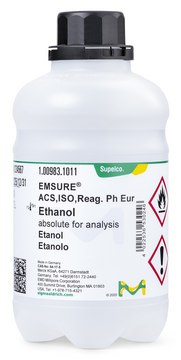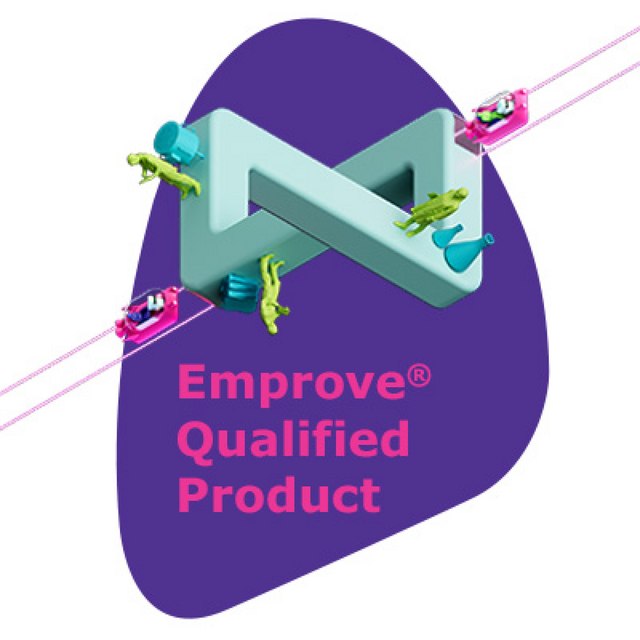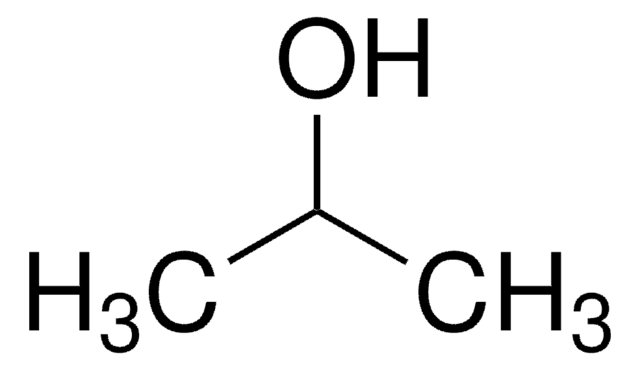P4937
Percoll®
pH 8.5-9.5 (25 °C), suitable for cell culture
Synonym(s):
Density gradient medium
Sign Into View Organizational & Contract Pricing
Select a Size
Change View
500 MG
RM 1,178.00
About This Item
Recommended Products
sterility
aseptically filled
Quality Level
form
colloidal
technique(s)
cell culture | mammalian: suitable
single cell analysis: suitable
pH
8.5-9.5 (25 °C)
density
1.13 g/mL±0.005 g/mL at 25 °C (lit.)
storage temp.
2-8°C
Looking for similar products? Visit Product Comparison Guide
General description
Percoll® is a classic medium for density gradient centrifugation of cells, viruses, and subcellular particles. It consists of colloidal silica particles of 15-30 nm diameter (23% w/w in water), which have been coated with polyvinylpyrrolidone (PVP). The PVP coating renders the product completely non-toxic and ideal for use with biological materials. Due to its heterogeneity in particle size, sedimentation occurs at different rates, spontaneously creating very smooth, isometric gradients in the range of 1.0-1.3 g/ml.
Application
Percoll consists of colloidal silica particles of 15-30 nm diameter (23% w/w in water) which have been coated with polyvinylpyrrolidone (PVP). It is used in cell separation and organelle isolation.
Percoll consists of colloidal silica particles of 15-30 nm diameter (23% w/w in water) which have been coated with polyvinylpyrrolidone (PVP). It is used to establish non-toxic low viscosity, low osmolarity density gradients that can be used to isolate cells, organelles and viruses. It has been used to separate inner and outer membrane vesicles from E. coli. Percoll is isosmotic throughout the gradient, non-toxic, and is easily removed from the purified materials.
Features and Benefits
- Low osmolality permits precise adjustment to physiological conditions without significant interference from the medium.
- Compatible with living cells and viruses and allows separation and recovery of intact, fully active systems.
- Impermeable to biological membranes, resulting in no change of buoyant density of particles during centrifugation.
- Spontaneous formation of gradient during centrifugation allows mixing of large sample volumes in the centrifuge tubes.
- Low viscosity results in rapid formation of gradients and particle separation.
- Most biological particles having sedimentation coefficient values greater than 60S can be successfully isolated in Percoll gradients.
Legal Information
Percoll is a registered trademark of Cytiva
Storage Class Code
12 - Non Combustible Liquids
WGK
nwg
Flash Point(F)
Not applicable
Flash Point(C)
Not applicable
Personal Protective Equipment
dust mask type N95 (US), Eyeshields, Gloves
Choose from one of the most recent versions:
Already Own This Product?
Find documentation for the products that you have recently purchased in the Document Library.
Customers Also Viewed
M G Mahoney et al.
The Journal of clinical investigation, 103(4), 461-468 (1999-02-18)
Patients with pemphigus foliaceus (PF) have blisters on skin, but not mucous membranes, whereas patients with pemphigus vulgaris (PV) develop blisters on mucous membranes and/or skin. PF and PV blisters are due to loss of keratinocyte cell-cell adhesion in the
D M Lovinger et al.
Science (New York, N.Y.), 243(4899), 1721-1724 (1989-03-31)
The ion current induced by the glutamate receptor agonist N-methyl-D-aspartate (NMDA) in voltage-clamped hippocampal neurons was inhibited by ethanol (EtOH). Inhibition increased in a concentration-dependent manner over the range 5 to 50 mM, a range that also produces intoxication. The
Y Gavrieli et al.
The Journal of cell biology, 119(3), 493-501 (1992-11-01)
Programmed cell death (PCD) plays a key role in developmental biology and in maintenance of the steady state in continuously renewing tissues. Currently, its existence is inferred mainly from gel electrophoresis of a pooled DNA extract as PCD was shown
S Enocksson et al.
The Journal of clinical investigation, 95(5), 2239-2245 (1995-05-01)
Although it is well established in several mammalian species that beta 3-adrenoceptors play a major role in regulating lipolysis and thermogenesis in adipose tissue, the functional existence and role of this receptor subtype in man has been controversial. We investigated
Gian Marco Leggio et al.
Neuropsychopharmacology : official publication of the American College of Neuropsychopharmacology, 39(8), 2017-2028 (2014-03-04)
Mesolimbic dopamine (DA) controls drug- and alcohol-seeking behavior, but the role of specific DA receptor subtypes is unclear. We tested the hypothesis that D3R gene deletion or the D3R pharmacological blockade inhibits ethanol preference in mice. D3R-deficient mice (D3R(-/-)) and
Our team of scientists has experience in all areas of research including Life Science, Material Science, Chemical Synthesis, Chromatography, Analytical and many others.
Contact Technical Service


